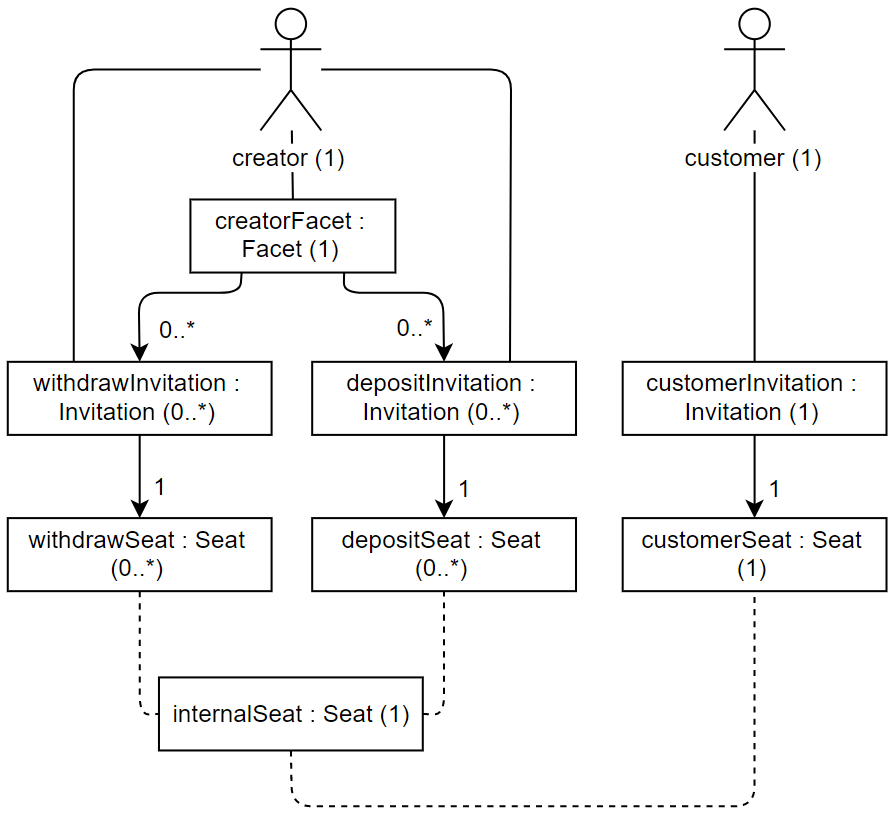The managed assets pattern
Intent
Creating a level of indirection between the creator of the smart contract and a potential customer.
Consequences
- There are an arbitrary amount of traders that all trade with the creator.
- The smart contract is able to run indefinitely.
- The creator does not need to play an active role in the trade: the
sole purpose of the trader is to provide input to the
internalSeatby offering adepositInvitation, and collect output of theinternalSeatby offering awithdrawInvitation. - The creator and the customer do not trade directly: both the
customer and the creator will only trade with the
internalSeat. - Due to the fact that the withdrawing is performed by offering a
withdrawInvitation, gains are given to anyone that offers awithdrawInvitation. The creator must therefore be careful not to share awithdrawInvitationwith any other entity, because any entity that offers thiswithdrawInvitationcan get the gains from theinternalSeat.
Structure
Note that this seat structure diagram does not
specify how the customer got hold of the customerInvitation. This is
because the way that the customer obtained the customerInvitation is
irrelevant for the managed assets pattern. An example of how the
customer could have gotten the customerInvitation is via the
independent participation pattern.
Participants
- Creator: the entity that starts an instance of the smart contract.
- Customer: the entity that wants to trade with the creator.
Implementation
const start = async zcf => {
const { zcfSeat: internalSeat } = zcf.makeEmptySeatKit();
const makeDepositOfferHandler = depositSeat => {
//some reallocation to internalSeat
}
const makeWithdrawOfferHandler = withdrawSeat => {
//some reallocation from internalSeat
}
const customerOfferHandler = customerSeat => {
//some reallocation to internalSeat
}
const creatorFacet = Far('creatorFacet', {
makeDepositInvitation: () => zcf.makeInvitation(makeDepositOfferHandler, 'deposit'),
makeWithdrawInvitation: () => zcf.makeInvitation(makeWithdrawOfferHandler, 'withdraw')
});
return harden({ creatorFacet });
};
harden(start);
export { start };
The smart contract has an internal seat internalSeat which is used as
a level of indirection between the creator and the customer. A customer
will perform all of its trades with the internalSeat. The smart
contract returns a creatorFacet. This creatorFacet provides the
creator with methods to create depositInvitations and
withdrawInvitations. A depositInvitation can be used in an offer to
deposit inventory to the internalSeat. A withdrawInvitation can be
used in an offer to withdraw gains made from the trades from the
internalSeat. Note that in the code above the
customerOfferHandler is not linked to any invitation. The contract
designer should determine how invitations are made available to
customers.
Known uses
- The oracle smart contract.
- The Over The Counter desk smart contract.
Related patterns
- The salesperson pattern: both these patterns are market places where 1 creator performs trade with an arbitrary amount of customers. The difference is that the managed assets patterns provides an extra level of indirection between the customer and the creator, while the salesperson pattern does not provide this extra level of indirection.
